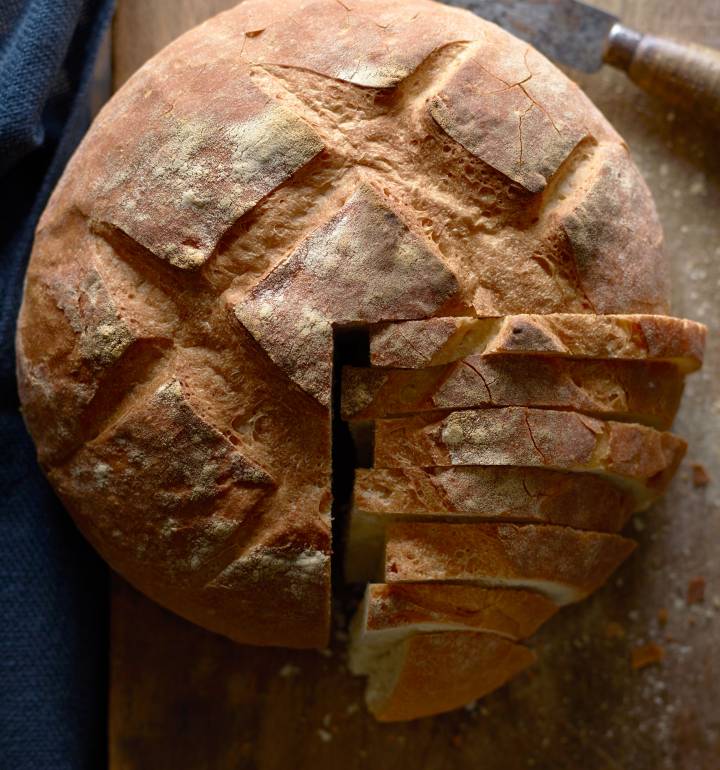Cheat’s sourdough
Makes: 1 large loaf – cuts into 20 slices

Storing your loaf: / Once your bread is thoroughly cold, it should be stored in a proper bread bin or container, rather than a sealed plastic box, well away from any sources of heat (room heaters, under-cabinet lights etc). Wrapping the loaf in a clean te
Cheat’s sourdough
Makes: 1 large loaf – cuts into 20 slices
See more recipes
Nutritional information (per serving)
Calories
111Kcal
Fat
0gr
Saturates
0gr
Carbs
23gr
Sugars
0gr
Fibre
1gr
Protein
3gr
Salt
0.5gr

Sainsbury's magazine
Our team of trained chefs and skilled food writers love cooking up everything from innovative seasonal recipes or clever shortcuts, to step-by-step guides and classic recipes for friends and readers alike.

Sainsbury's magazine
Our team of trained chefs and skilled food writers love cooking up everything from innovative seasonal recipes or clever shortcuts, to step-by-step guides and classic recipes for friends and readers alike.
Ingredients
- 600g strong white bread flour, plus extra for dusting
- ¾ tsp fast-action dried yeast (from a 7g sachet)
Step by step
Get ahead
This loaf keeps well for 2-3 days and freezes well.
- Put 225g of the flour and the yeast into a medium-sized bowl and mix well with your hand. Trickle 225ml of room-temperature water into the bowl, mixing it into the flour to make a thick and very sticky mixture. Cover the bowl with a damp tea towel and leave on the worktop for 24 hours. Re-dampen the tea towel from time to time – the mixture will bubble up and expand by three or four times its original volume, and then fall back.
- Uncover the bowl and stir in another 175ml of water then tip the mixture into a larger bowl. Sprinkle 175g of the remaining flour plus 2 tsp salt into the bowl and work in with your hand. When it's all incorporated, work in enough of the remaining 200g flour to make a soft but not sticky dough. Turn the dough out of the bowl onto the worktop lightly dusted with flour and knead thoroughly for 10 minutes or until the dough feels very elastic and pliable (you can also knead the dough using a stand mixer and the dough hook for 5 minutes on a low speed).
- Return the dough to the bowl and cover it tightly with clingfilm and leave to rise on the worktop until it has doubled in size – this will take 2 to 3 hours but it depends on the room temperature and the liveliness of the dough. Lightly flour your knuckle and punch down the dough to deflate it then turn the dough out onto a worktop sprinkled with flour. Gently shape the dough into a neat ball then set it in the centre of a baking tray lined with baking paper. Slip the tray into a large plastic bag then slightly inflate the bag so the plastic doesn't touch the dough and close the ends. Leave to rise and prove on the worktop until doubled in size – about 1 hour 30 minutes. Towards the end of the rising time preheat the oven to 220°C, fan 200°C fan, gas 7 and put an empty roasting tin into the bottom of the oven to heat up.
- When the dough is ready, remove it from the bag and quickly slash the top of the loaf with a sharp knife. Put it in the hot oven. Working quickly, pour a jug of water or ice-cubes into the hot roasting tin and close the oven door. The steam produced will give a good crisp crust. Bake for 35 minutes or until the loaf is golden and sounds hollow when tapped underneath. Leave to cool on a wire rack and slice when completely cold.
Chef quote
A 'proper' sourdough is made from a starter of flour and water left to ferment for several days. The mixture absorbs natural yeasts from the air, which start to grow and produce bubbles of gas, and needs to be regularly 'fed' with fresh flour and water to keep it going. In this easy, quicker method, a little yeast speeds the process while the 24-hour fermentation means the bread still has a real flavour plus a chewy crumb (with the characteristic irregular holes) and crisp crust.




